|
Preface:
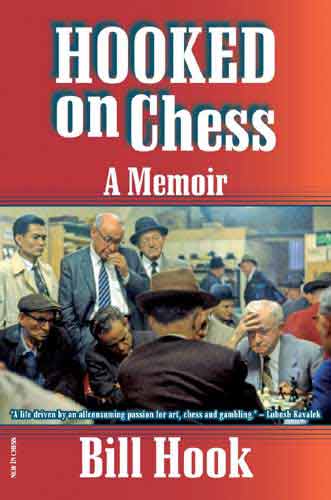
"Amidst the bright lights of
movie theaters, near Hubert's museum and flea circus, and above the garish fast
food eatery there were some large windows. Painted signs on glass read
'The
New York Academy of Chess and Checkers.'
'Games Arranged.'
'10¢ per hour.'
I climbed a narrow stairway and found myself in a long dingy room crowded with
men and thick with smoke. A few checker players were in the back,
but most of the games being played were chess..." -Bill Hook
My
dear friend, Deb, a voracious and eclectic reader, finished reading Bill Hook's
memoirs, Hooked on Chess. As usual, she did a bit of research on her own
concerning some of the things mentioned in the book. One of those things mentioned
was the Chess and Checker Club of New York, aka The Flea House - pictured on the
cover of the book.
Deb sent me pertinent text from
various sources Mr.
Hook's book, the NY Times
articles shown below, as well as the New Yorker article, and Andrew
Soltis' article for Chess Life, along with some information on the Log Cabin Chess Club.
Outside of a bit of knowledge about Lisa Lane I'm not well versed in that era of
chess, so I nosed around a bit to try to get a handle on things so I could try
to tie all this information together and present it in some coherent fashion.
New York
Times, Feb. 16, 1960
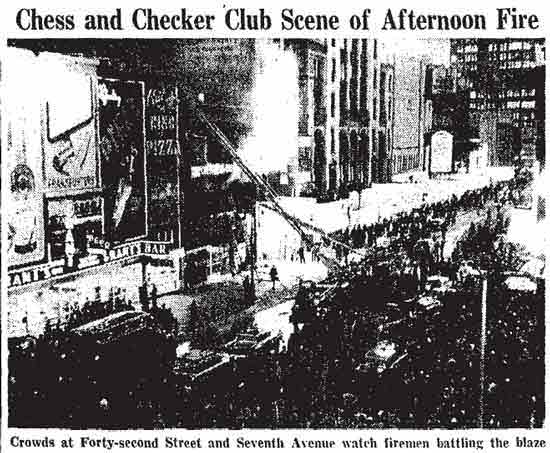
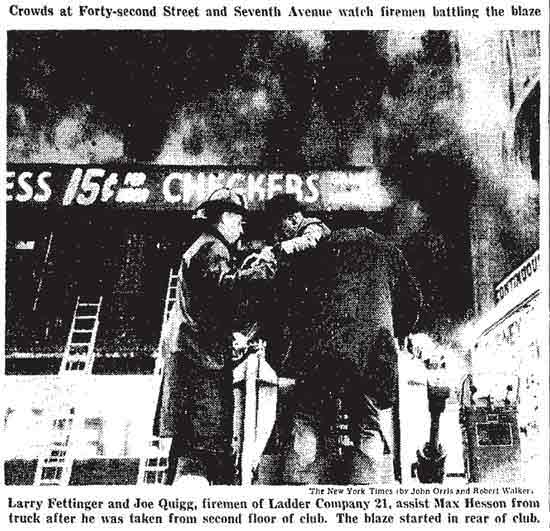
|
Many at Club Led to Safety by Off-Duty
Patrolman
A chess playing patrolman was given credit yesterday
for averting panic and saving scores of lives when fire broke out in a
West Forty-second Street chess and checker club.
Patrolman Herbert Roberts, who was off-duty, was
playing chess in the Chess and Checker Club of New York on the
second floor of 210 West Forty-second Street when the fire was
discovered shortly after 5 P.M.
The blaze started in the read of the club. It was
believed caused by fire in a grease duct of a Hector's Cafeteria, which
occupies the street floor. The top floor of the three-story building is
occupied by the Hartnett Music School.
The 150 men in the club began to panic. Some ran
toward the rear, seeking to go down the fire escape, but flames and smoke
drove them back. Of the two doors in the front, one was locked and sealed
off with an iron grill.
As the men began to press around the one exit,
Patrolman Roberts led a group to the windows at the front. He directed the
men to smash the windows and get out onto a narrow iron balcony along the
face of the building. From there, about thirty men clambered onto the
marquee of the New Amsterdam Theatre next door.
After seeing this group to safety, Patrolman Roberts
crawled through the smoke to the men milling around the exit. He calmed
their dears and directed them out inn an orderly fashion.
He was the last to leave. He then went to the movie
house and advised the manager to empty the theatre because of the fire
next door.
Firemen responding to an alarm turned in at 5:20 P.M.
led another group to thirty men who had gathered on the balcony down the
aerial ladder. No one was injured.
The fire caused traffic to be diverted off Forty-second
Street between Broadway and Eighth Avenues for almost an hour.
|
New York Times, Dec. 6, 1959
These ladies are participating in the national
chess tournament sponsored by the Log Cabin Chess Club and the US Chess
Federation. The venue is the Mary Bain Chess Studio.
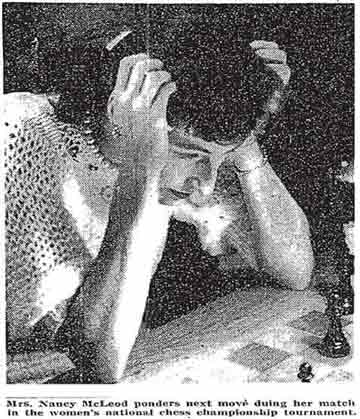 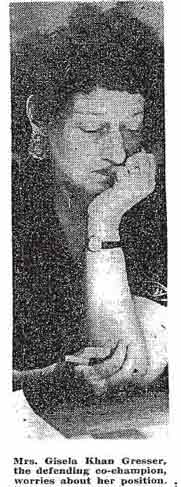 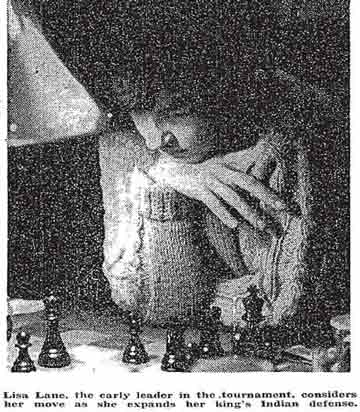
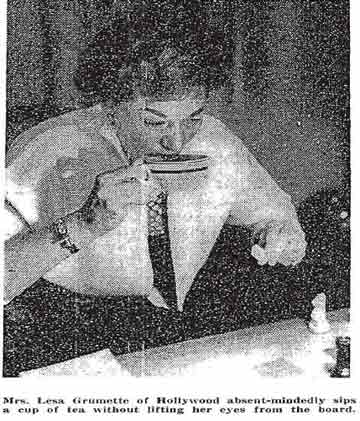
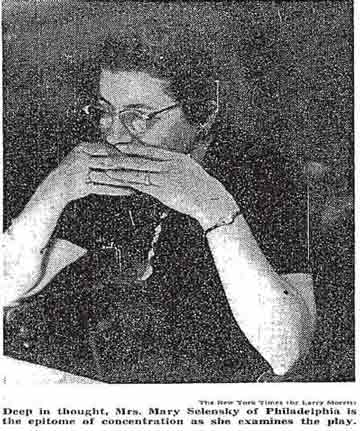
Adjourned Games
Slow Chess Play
Lisa Lane of Philadelphia held a tentative lead over Mrs. Gisela Gresser of New
York, the defending champion, as the fifth round play
began today in the woman's national chess tournament at the Log Cabin Chess
Club in West Orange, N.J.
Two games adjourned during the fourth round Friday night will not be resumed
until Wednesday, thereby leaving the standings
undetermined.
Miss Lane went into the fifth round with a 3½-½ score, as compared to Mrs.
Gresser's 3-1.
Of the others, Mrs. Eva Aronian of Chicago and Mona N. Karff of New York were
counted on to harass the leaders. Mrs. Gresser's only loss thus far was in the
third round to Miss Karff, holder of the title no less than six times in the
past. Miss Karff and Mrs. Gresser, in addition to Mrs. Mary Bain, who is now
retired, have represented the country internationally.
Today's program calls for four games. The tournament, sponsored jointly by the
Log Cabin Chess Club and the United States Federation, has drawn nine invited
players from New York, Pennsylvania, Illinois, Indiana, California and Arizona.
It is being directed by E. Forry Laucks, president of the club and
vice-president of the chess federation.
note 1 : "Mrs. Lesa Grumette"
should be "Mrs.Lena Grumette." Gresser, Bain, Selensky and Grumette all
participated together in the 1948 S Women's Championship (Gresser, 1st; Bain
3rd; Grumette 4th and Selensky 7th out of 8 total).
note 2 :
details on
Nancy McLeod
note 3 : E. Forry Laucks not only
founded but also supported the Log Cabin Chess Club of West Orange, N.J.
According to
Chess Dryad, "Laucks loved to barnstorm around the world. The Log Cabin
traveled to such far flung places as Cuba (With a young Bobby Fischer) and
Alaska. During these trips members remembered the golden rule: Don't let Forry
drive! An animated conversationalist, Laucks was known to look his listener in
the back seat in the eye while driving down the road. This resulted in a few
nicks and scrapes, but Forry was ready to handle the situation. If his car was
undrivable, he would simply leave it by the roadside, flag a ride and go into
town and buy a new one. It didn't hurt that Lauck's father had left him a
sizable inheritance."
According to Sam Sloan who needs no introduction,
"E. Forry Laucks was one of the great patrons of the game of chess from the 1930s
until his death on July 31, 1965 during the US Open Chess Championship in Rio
Piedras, Puerto Rico. In 1934, Laucks established the Log Cabin Chess Club in
his home at 30 Collamore Terrace, West Orange, New Jersey. All the top players
played there for the substantial cash prizes he offered at the major tournaments
held there. Fischer, Lombardy, the Byrne Brothers, Benko, Evans, Bisguier and
all the other big names in chess played there."
Accordng to Bill Hook in Hooked on Chess, the
1959 tourney was played in both the NJ home of Laucks and the NY Chess Club (i.e.
the Mary Bain Chess Studio): "The tournament was offered to the top 10 players in the country,
and
of course included 5 time US champion Sammy Reshevsky, but there was a catch. Laucks came up with a schedule that included games on Friday night and Saturday,
which would preclude the participation of Reshevsky , an orthodox Jew. Sammy
wanted to play and an effort was made to book the games around the Sabbath, but
Laucks was adamant until a players' meeting was suggested to decide the issue.
Laucks agreed, but insisted that Reshevsky could not play unless there was a
unanimous vote in his favor. Of course, one player vetoed Sammy on 'personal
grounds' and one wonders whether Laucks knew that in advance. Also, the fact
that among many photos hanging in Laucks' home were several that prominently
displayed the Nazi flag makes one wonder even more. Former US champion Arnold
Denker was outraged and Chess Review editor I A Horowitz labeled the incident as
a dark day in the history of chess."
New York Times, Aug.
20, 1959
Lombardy Beats Kalme in Chess
"William Lombardy defeated Charles Kalme of Philadelphia in twenty-six moves
last night and increased his lead in the Log Cabin Chess Club tournament at the
Mary Bain Chess Studio." [The Mary Bain Chess studio was located on
145 west 42nd street.]
NM Lonnie Kwartler had written Sam
Sloan a note (published
online by Sloan) concerning The Flea House (Sloan refers to Kwartler as "an
old-time denizen of the Flea House, who grew up to become a reputable public
school teacher") in which NM Kwartler states: " . . .The Fleahouse (one or
two words) reflects the location of a flea circus on 42nd St. There was still
one down the street to the west."
". . .Regarding Harold Fischer: I called him a Canadian checker player, but I do
not recall his nationality. I remember now that he had a sign in his place
stating that he won championships in Canada and New York. He had Fursa's club
before Fursa. I heard that Fursa worked for Fischer and obtained the club in
some unethical way. I was not able to check that. John gave up the club for
health reasons. Collapsing can be convincing. His main worker, Cal, got it."
"Cal" would be Cal Morris.
Mr. Hook maintained that Morris was an able manager who fit well in the chess
scene at the Flea House, but who was forced to sell after an unexpected rent
increase that was beyond his means.
New York Times, May
18, 1966
Harold Fischer,
Checkers Expert
Ex-Operator of Clubs Dies
- Won Canadian Title
Harold Fischer, a checkers master, who established
several unusual chess and checkers clubs in the Times Square area died on Monday
in Toronto. His age was 57.
Mr. Fischer, a sufferer from muscular dystrophy, died
of pneumonia.
Last November, he sold his chess club at 109 West 42d
Street to George Brady, a checkers champion, and went to live with his brother,
Fred, in Toronto. He formerly lived at the Commander Hotel, 240 West 73d Street.
Canadian-born, Mr. Fischer became a checkers phenomenon
in his youth. He won the Canadian championship in 1925.
He subsequently came here and operated the Manhattan Chess and Checkers Club at
212 West 43d Street in partnership with John Fursa.
The club, which was largely Fischer's idea, was unusual
in that anyone could walk in off the street and, for a fee, engage in a game of
checkers, chess or bridge, provided opponents or partners were available. Many
exhibition matches were also staged there.
Besides his brother Fred, Mr. Fischer leaves his wife, Catherine; another
brother, Harry, and two sisters, Mrs. Lina Nick and Mrs. Sadie Rodney.
Fischer is the
actual spelling used in the obituary. As Bob Podoff, who was writing about the checkers
champion, Samuel Gonotsky correctly stated: "The time was 1946 and I frequented
Harold Fisher's (not Fischer) checker club, called "The New
York Academy of Chess & Checkers" in Time Square every Saturday."
[parenthetically, Sam Gonostsky, a part-time Western Union messenger, was
the (checkers only) operator for the chess/checker automaton Ajeeb when it was
owned by Mrs. Elmore and exhibited at Hamid's museum on Surf Avenue - not
Hamid's Million Dollar Pier- in Coney Island]
Describing Harold Fisher, Bill Hook
wrote:
"The New York Academy of
Chess and Checkers had been opened a few years before by a Canadian Checkers
champion named Harold Fisher, and so it came to be known as "Fisher's." He was a
genial, bald, stoop-shouldered man, and well liked. Fred and Willie helped him
run the place. Fred was his brother-in-law, whose bulk, broken nose and rolling
gait made him seem like a former club-level boxer, which he may well have been.
Willie was tall, thin, had thick glasses, and always wore a cap, suspenders, and
a tie-less colorful shirt. He had twinkling eyes, a ready smile, and a very soft
voice, but he rarely initiated a conversation.
Fisher's was always well patronized; it was
consistently crowded, even during the war years when few men of military age
were around. The informality of the place was an appealing factor; the 'club'
had no membership and anyone cold walk in and play for a modest fee, or just
watch if the so chose, no sales pressure was ever applied. And somehow it
worked! Of course, the club's prime location brought many people to that area.
The transportation lines converged on a district densely packed with fine
restaurants, theaters including the Metropolitan Opera House just two blocks
away, cinemas and countless stores and offices.
Two major contributors to Fisher's clientele were the
nearby garment industry and jewelry trade district. These businesses were
traditionally practiced by Jews, stemming from the olden days in Europe when
other professions were closed off to them. With their natural predilection to
chess, Fischer's attracted many Jews, who thereby contributed to the club's
cultural enrichment. Yiddish was often spoken, and over the years I picked up a
lot of words and phrases. An onlooker was called a kibitzer, for instance, and a
poor player was a patzer. I actually got to the point where I evoked the opening
phrase of the Kaddish (prayer for the dead) when my opponent had a busted
position. Lest this seem like bad manners to you, it was in keeping with the
tradition of 'coffee house chess,' as I came to learn. (Yes, coffee was
available.)"
Additionally, Mr. Hook informed us
that, "After Fisher partnership with Fursa ended with Fursa retaining
ownership of the club, Fisher immediately opened another place a block away, but
was able to lure only a small number of players away. then Larry Evans, in
partnership with Aaron Rothman, bought out Mary Bain's club. so at this time
there were 3 clubs operating within 2 city blocks on 42nd street."
again from Bill Hook:
Once each year the
strongest clubs in the New York area played a series of round-robin matches on
eight boards. This was called the Metropolitan Chess League, and the
participating teams were the Manhattan, Marshall, Fisher's, Brooklyn, Queens,
Bronx, London Terrace and Log Cabin clubs. The Manhattan and the Marshall
clubs usually took turns winning; Fischer's often came in 3rd, Playing at the
Log Cabin and London Terrace was interesting. The Log Cabin in New Jersey was
the home of an eccentric millionaire named E. Forry Laucks; playing first
board for them was Franklin Howard. The London Terrace matches were held in a
penthouse of the stylish London Terrace apartments. The fames artist Marcel
Duchamps played there. I was paired with him and we drew a queen vs. three
pieces game. He had a very genteel demeanor. I asked his what type of art work
he was currently doing and he smile graciously and said, "I'm on a long
vacation." An earlier encounter with Duchamp at the New York State
Championship in 1951 had produced this result:
Bill Hook vs. Marcel Duchamp
[The 1951 New York Championship
was eventually won by James Sherwin]
I was the captain of
the Fisher's team for a while, and we always looked forward to our match with
the Manhattan in that they represented in our minds a somewhat haughty
establishment, and we were the gallant proletarians, out looking for a big
upset.
One year we were to host the match, and it was a daunting prospect, since the
Manhattan would have Pal Benko on 1st board, and he was then winning most of
the weekend Swiss tournaments. But we hit upon the idea of putting Sam Richman
on our first board. It was clearly our intent to offer Sam as a sacrifice to
Benko, and that would make us relatively stronger on all the lower boards.
Richman had never been a tournament player to our knowledge, but there was a
semblance of logic to the pairing in that after the death of Treyeman, Sam was
sort of king of the coffee house players. He was very pleased by our asking
him, probably unaware of his sacrificial role. Of course he couldn't handle
either the clock or Benko's play, and lost very quickly, apologizing as he
went back to his customers. But the tactic worked! We won the match 5 to 3 and
I. A. Horowitz devoted his New York Times column to "42nd Street chess."
We were euphoric.
New York Times June 9,
1963
CHESS: ACTION ON 42d STREET
By Al Horowitz
The Chess and Checker
Club of New York on 42d Street, in the center of Times Square, is a world unto
itself. For some it is a sanctuary, for others a way of life. For many, a
testing ground to prove their mettle.
This club links three eras. Here you will find the last veterans
from the East Side coffee-houses. These old-timers who never read a chess book
and whose only opening is "the old army game," the Giuoco Piano, are fierce
competitors, ready to give or take any outlandish odds. As fiercely as thay
assail their opponents with verbal barbs, they turn sharply upon their
kibitzers.
Then, there is the quorum of experts, masters and occasional grand
masters, whose ranks are often spiced by a visiting chess celebrity from Europe
or South America.
Thirdly, there is the vast array of picturesque young players,
brilliant and edgy, always primed for action. These are the rapid-fire,
rapid-transit, "five-minute-clock" players.
The regular run-of-the-mill chess lovers who never miss their daily
session find the club a duffer's haven. The world's famous and would-be famous
are seldom absent. From the opening time, about 11 A.M., until early morning,
the atmosphere is electric, raffish, sharp - and unpredictable.
Anything can happen and usually does.
Recently, at the club's quarters, a grievous blow was dealt an
eight-man team from the famous Manhattan Chess Club by the home team, 5 -3. The
Chess and Checker Club winners were Harry Baker, Joe Balint, Harold Feldheim and
Bill Hook. The defeated James Gore, Brian Owens, George Shainswit and Paul
Brandts, respectively. Manhattan winners were Pal Benko and Alexander Kevitz,
who defeated Sam Richman and I. Kerman, respectively. S. Tomchin, Chess and
Checker drew with R. Steinmeyer, Manhattan, and J. Serenyi, Chess and Checker,
drew with Dr. H. Sussman, Manhattan.
In his Chess Life Article,
Andy Sotis referred to some of these things:
Then it tried to gain
respectability. It took out ads in magazines that read "A Famous Chess
Rendezvous . . . Games arranged . . . Refreshments served / NO MEMBERSHIP FEES."
It also got good press. Harold Feldheim, a USCF expert and
Fleahouse denizen, was reputedly one of Al Horowitz's ghosts. That may be why
this game was featured in Horowitz;s New York Times column of June 2, 1963 [
here he included a game between Harold Feldheim (w) and George Shainswit (b),
won by Feldheim]
. .
.
[writting about how the Fleahouse
was doing the unthinkable - winning the Metropolitan Chess League tournament]
The Fleahouse
win the met league? sacrilege!
I remember how the only obstacle in its path to the title the year was my team,
the Marshall Juniors. Before our crucial match our captian, Dave Daniels,
another Horowitz ghost [writer], delivered the best pep talk I can recall. It
ended with:
" If we let this lice- ridden, flea-bitten,
pack of mongrels win the Met league, we might as well give up chess."
We lost anyway."
The Stanley Kubrick film, The
Killing, was filmed in part at the Chess and Checker Club of New York or "the
Academy of Chess and Checkers," later known as The Flea House. Kubrick, a former chess hustler and frequenter of
The Flea House and other such
venues, ". . . delved into his Greenwich Village experiences to flesh out
characters like Maurice, the wrestler who provides a diversion during the
robbery. An old chess buddy, Kola Kwarian, played him, and Kubrick set the scene
where Johnny meets him at the "Academy of Chess and Checkers," based on th New
York "Flea House" where Kubrick used to play." (from Stanley Kubrick by
John Baxter)
"To eke out his unemployment
insurance, Kubrick began hustling chess games, a popular practice among the
younger players. [Alan] Kaufman [who would later be executive director of the
American Chess Foundation] and his friends would play at The Flea House until
they had won enough to pay for a meal, then, after dinner, hustle enough for a
movie. Kubrick preferred to play Washington Square area, near MacDougal and West
4th Streets. The fixed concrete boards were free - at The Flea House players
paid by the hour and the open air offered the maximum number of kibitzers
- spectators and potzers - patsies. By timing his games carefully,
Kubrick occupied a shaded board by day but switched to one under a street light
as night fell. He remembered a typical take for a twelve-hour day as around $3 -
'which goes a long way,' he told his friend years later, 'if all you are buying
with it is food' - but he almost certainly made much more."
- also from Stanley Kubrick by John Baxter
According to
Bill Wall,
"The Academy of Chess and Checkers was a mock up of the 42nd Street Chess and
Checker Parlor in New York City. Both Kola and Stanley were regular chess
players there."
"Clay goes to the Academy of Chess and Checkers (the Flea House), looking for a
buddy of his. He passes by several chess games in progress until he reaches one
being overseen and kibitzed by big 250 pound Maurice Oboukhoff ( [played by]
Kola Kwariani (1903-1980) ). The club is run by a guy named Fischer. Clay
interrupts the kibitzing to talk to Maurice. They go to an empty chess table by
the window where Clay offers Maurice $2,500 to start a fight diversion for a
robbery at the race track. When Clay asks Maurice how's life been treating him,
Maurice says, "About the same as always. When I need some money, I go out and
wrestle. But mostly I'm up here, wasting my time playing chess. But I wouldn't
know what to do with myself if I didn't have this place to go to."
Again, according to NM Lonnie
Kwartler "Saturday night TCM showed "The Killing." I saw it in a drive-in
in 1958. A few year later, I met Nick. [Nicholas "Kola" Kwariani] I
was "one of the few" who knew his name. He told me he was born in 1900. He gave
me a check in his later years that had a Queens address (which I didn't save
long after his death). The self-described "Great Richmond," who died in 1970,
also told me he was born in 1900. I knew his [The Great Richmond's?] name was Sam Reichman. Muggings also shortened his
life, I think."
"During my first year
at 42nd Street, a man named Sam Richman made a singular impression upon me. He
was perhaps 35 at the time, tall, had a thick head of black hair, and one eye
had an ominous black spot in the corner, which belied his essentially gentle
nature. I later learned that Sam had been married and owned a delicatessen in
Brooklyn in the 1930's. A strong player, he plunged into a series of
increasingly high stakes games with George Treysman, lost his delicatessen, and
then his wife left him. His life in ruins because of chess miscalculations, he
then
chose to become a hustler for the rest of his life!
I observed Sam for almost 30 years on 42nd Street, often giving
odds that were too generous. The erect, imposing man with black hair gradually
changed: his hair grayed; his posture stooped; he limped and when he lost some
teeth, his face became a sunken caricature of his former noble features. A sad
chess tale, but surely a variant of our own deterioration if we survive long
enough. The more important things to consider with Sam Richman, is that he was
an honorable, talented, good person who was well liked, and thereby thrived in
his own way during his many years on 42nd Street." -Bill Hook, "Hooked
on Chess"
Mr. Kwartler elsewhere mentioned:
"The Flea House designated the Chess and Checker Club of New York, which was
located on 42nd Street near Times Square. It was a place where players could
come and play chess, checkers, Russian checkers, Spanish checkers, dominoes, go,
backgammon, scrabble, gin rummy, and bridge. The strength of the chess players
ran the gamut from unrated to grandmaster. The range of customers was wide
whether from the perspective of social (or antisocial) class or nationality. At
times there were organized tournaments, simuls, and team matches. However, the
place was best known for unrated chess played with or without stakes. The terms
for these were sociable or hustling."
The Flea House from "The Killing" -
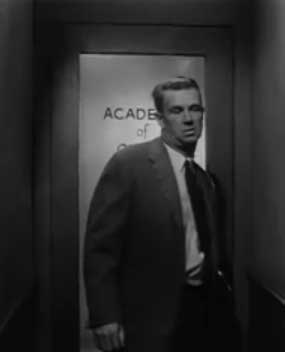
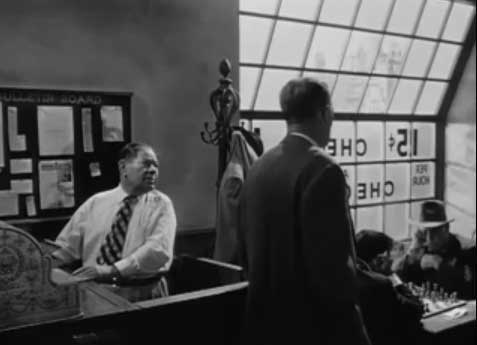
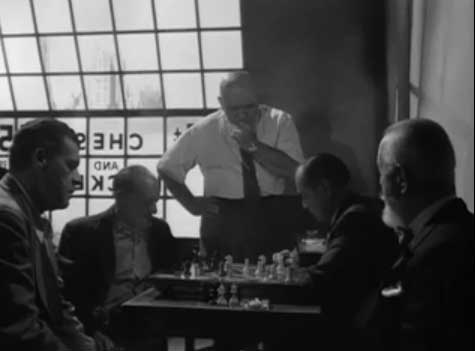
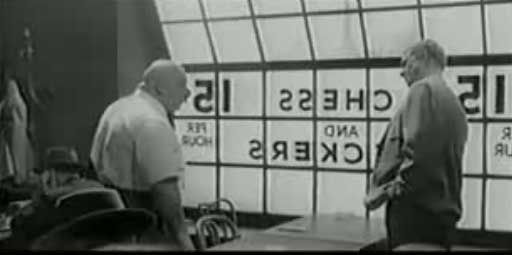
The New Yorker of Dec. 6,
1999 listed this story:
SKETCHBOOK: The Chess Parlor on Forty-second Street. by Edward Sorel
Missing Pieces
"I was never much of a chess player, but in the early
fifties I used to hang around the Chess & Checker Club of New York. Occupying
the second floor of a decrepit walk-up next to the New Amsterdam Theatre, on
Forty-second Street, it was open twenty-four hours a day, seven days a week. At
night, the neon of a dozen theaters made the street entrance easy to miss, but
after 4 A.M., when the marquees went dark, the light from the club's large
windows became a beacon, attracting the dispossessed as well as the chess
possessed.
John Fursa owned the place. He was not amused when some
of the regulars referred to it as "the fleas house." In fact John kept his
establishment fairly neat. He regularly emptied ashtrays, collected abandoned
coffee cups (china), and supplied plenty of hangers (wooden) for coats. There
was a prohibition on betting and no embargo on bringing food from Grant's, the
all-night fifteen-cent-hamburger joint on the corner. Sometimes John would
shatter the quiet with an explosion of expletives, signalling that another chess
piece was missing. Someone, he said, was stealing them, one or two at a time,
with the clear intention of accumulating a complete set. As far a I know, he
never did catch the culprit.
Inept as a detective, John did better as a matchmaker,
finding partners for patrons who showed up solo. Some nights, however, there was
no one who played as poorly as I did, so I stood around watching the masters.
One of them was an intense young man with heavy-lidded eyes. Years later, I saw
his photograph in Sight & Sound, above a caption identifying him as
Stanley Kubrick, director of "The Killing."
In time, Forty-second Street morphed into a gantlet
(gauntlet?) of porno theatres and sex shops, and in the eighties the club closed
its doors. Now, with the street Disneyfied, nothing as unprofitable as a
forty-cent-an-hour chess parlor is likely to reappear. Pity. It was a good place
to enjoy solitude without being alone. -E.S.
Mr. Hook also wrote of the gradual deterioration of
42nd Street and the club itself : "The metamorphosing from
The New York Academy of Chess and Checkers, to Fisher's, to Fursa's, to the
final despicable "Flea House" seemed to point to its downfall."
|

